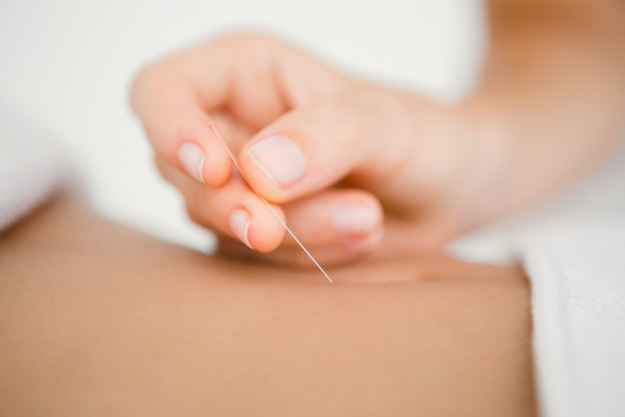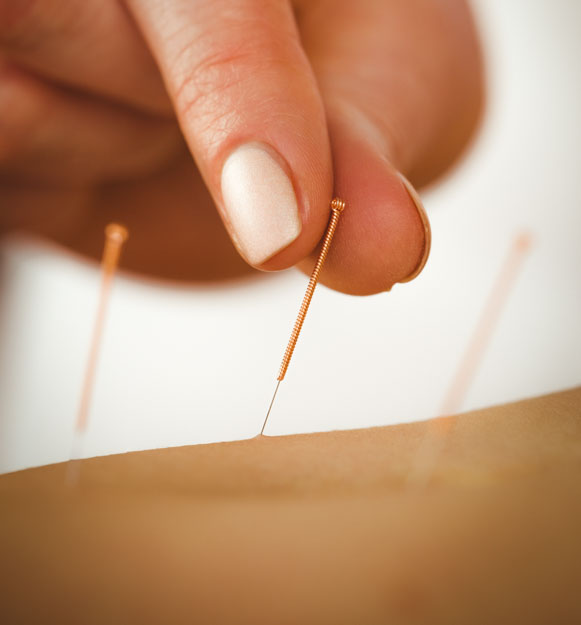Acupuncture relieves menstrual pain and cramping. Researchers from the Xianning Hospital of Traditional Chinese Medicine investigated the efficacy of triple acupuncture with moxibustion for the treatment of dysmenorrhea. The research team concludes that triple acupuncture is significantly more effective than conventional acupuncture for the relief of menstrual pain and cramping. 
Triple acupuncture achieved a 96.7% total effective rate. Conventional acupuncture achieved a 90% total effective rate. The total effective rate included patient improvements ranging from significant pain relief to complete resolution of all pain.
Two treatment groups receiving acupuncture plus moxibustion were compared. The groups differed in that triple acupuncture was applied to acupuncture point Zhongji (CV3) in only one of the groups. The following acupuncture points were applied to all patients:
- Zhongji, CV3
- Sanyinjiao, SP6
- Diji, SP8
- Shiqizhuixia, MBW25
Additional acupuncture points were applied based on varying presentations of diagnostic patterns. For qi and blood related diminished circulation with excess blood clotting, acupoints were added including:
- Hegu, LI4
- Taichong, LV3
For patients with chills and excess dampness, moxibustion was added to acupoint Shuidao (ST28). For patients with liver deficiency combined with heat and dampness, Yanglingquan (GB34) was added. For patients with qi and blood deficiency, the following acupoints were added:
- Xuehai, SP10
- Piyu, BL20
- Zusanli, ST36
Prior to treatments, all patients were asked to urinate. Next, patients rested in a supine position and the acupoint sites were disinfected. Filiform acupuncture needles (0.30 mm x 50 mm) were used on all acupoints. Total needle retention time was thirty minutes and manual acupuncture needle stimulation was applied every ten minutes. Acupuncture began five days prior to menstruation at a rate of once per day. Acupuncture ceased after the fifth treatment at the onset of menstruation. This process was repeated for four courses of care for a total of twenty acupuncture sessions.
Perpendicular needle insertion was applied to all acupuncture points except for CV3 in the group receiving triple acupuncture. A special acupuncture procedure was applied to CV3 for the triple technique. The needle was inserted at high speed and then angled towards Qugu (CV2). The needle was inserted from CV3 through CV2 to a point reaching the midpoint of the upper edge of the pubic bone.

Two additional needles were inserted near CV3 and angled towards CV2 in the same manner as the initial CV3 insertion. These points were located 3 mm lateral to CV3, bilaterally. Correct insertion included the elicitation of deqi. The patients reported deqi sensations of soreness, numbness, fullness, or pain radiating towards the perineum as verification. An electrical sensation also indicated the arrival of deqi. Mild moxibustion to CV3 was applied during needle retention.
Manual acupuncture techniques were adjusted for patients based on diagnostic presentations. Lifting manual acupuncture techniques were applied to patients with qi and blood circulation impairment with blood clots, chills, and dampness. Mild reinforcing and reducing techniques were added for patients with liver deficiency combined with damp heat. For general qi and blood deficiency, thrusting techniques were used for tonification.
The triple acupuncture technique increased the efficacy rate by 6.7%. Conventional perpendicular insertion acupuncture achieved a 90% total effective rate. Triple acupuncture achieved a 96.7% total effective rate. The researchers concluded that triple acupuncture combined with moxibustion is highly effective for the relief of primary dysmenorrhea.
These findings are consistent with those of Zhou et al. that were published in the Journal of Clinical Acupuncture and Moxibustion. Zhou et al. investigated the efficacy of acupuncture and moxibustion for the reduction of menstrual pain at the Affiliated Hospital of Hubei College of Medicine and Pharmacy. A combination of acupuncture, herbal hot compresses, and moxibustion outperformed ibuprofen (300 mg, three times per day). The herbal compress consisted of the following:
- Dan Shen
- Yan Hu Suo
- Yi Mu Cao
All patients received acupuncture at the following acupoints:
- Sanyinjiao, SP6
- Zusanli, ST36
- Guanyuan, CV4
- Qihai, CV6
For patients with excess, the following acupoints were added:
- Taichong, LV3
- Diji, SP 8
For patients with deficiency, the following acupoints were added:
- Xuehai, SP10
- Geshu, BL17
Reinforcing and reducing acupuncture techniques and moxa were applied. Each treatment session was thirty minutes. Treatments started one week prior to menstruation at a rate of once per day for six consecutive sessions that ended upon the first day of menstruation. This process was repeated an additional two times for a total of three courses of care. After analyzing the data, the researchers concluded that acupuncture plus moxa and herbal compresses is more effective than ibuprofen for the relief of menstrual cramping and pain.
References:
Lu Y. (2014). Therapeutic Observation of Triple Acupuncture at Zhongji(CV 3) plus Mild Moxibustion for Primary Dysmenorrhea. Shanghai Journal of Acupuncture and Moxibustion. 33(7).
Zhao NX, Guo RL, Ren QY et al. (2007). Acupuncture therapy in treating primary dysmenorrhea, treatment efficacy and hemorheology study. Zhejiang University of TCM Journal. 31(3): 364-365, 367
Zhou, Juan. “Acupuncture and Moxibustion plus Herbal Hot Compress for Primary Dysmenorrhea.” Journal of Clinical Acupuncture and Moxibustion 60.2 (2014): 11-13.


